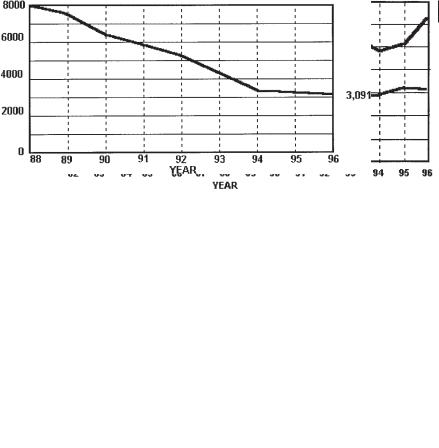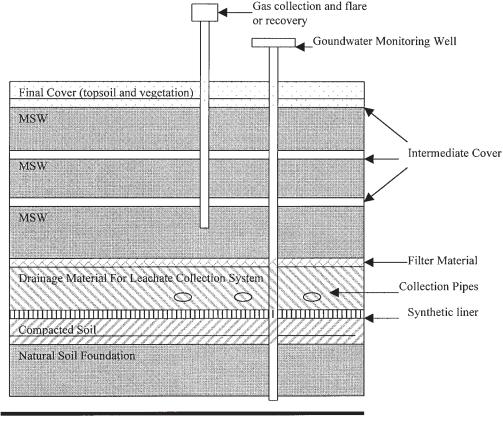
Environmental Biotechnology - Jordening and Winter
.pdf
16.2 Integrated Waste Management 397
Table 16.2 Comparison data: solid waste stream composition (% by mass) (according to O’Leary and Walsh, 1992).
Solid Waste |
Medford, |
Franklin |
Illinois Department |
Cal |
|
GBB Metro |
|
Component |
Wisconsin |
1990 |
of Natural Resources |
Recovery |
Des Moines |
||
|
1988 |
Study |
Estimate |
Guidelines |
1988 |
Study |
|
|
|
|
|
|
|
|
|
Food waste |
22.80 |
8.39 |
8.00 |
8.80 |
|
10.00 |
|
Yard waste |
11.80 |
19.80 |
20.00 |
28.20 |
11.00 |
||
Other organic |
16.20 |
7.92 |
11.00 |
8.90 |
|
7.80 |
|
Subtotal |
50.80 |
36.11 |
39.00 |
45.90 |
28.80 |
||
Newsprint |
3.10 |
|
5.15 |
|
7.30 |
|
5.20 |
Corrugated |
6.20 |
|
7.31 |
|
6.70 |
|
10.80 |
Mixed paper |
5.60 |
|
24.39 |
|
19.10 |
32.70 |
|
Subtotal |
14.90 |
36.85 |
37.00 |
33.10 |
48.70 |
||
Ferrous metal |
5.20 |
|
7.45 |
|
3.20 |
|
4.90 |
Aluminum |
1.60 |
|
1.34 |
|
1.00 |
|
0.30 |
Other metal |
0.20 |
|
0.20 |
|
0.70 |
|
0.20 |
Subtotal |
7.00 |
|
8.99 |
6.00 |
4.90 |
|
5.40 |
Plastics |
7.10 |
|
7.92 |
7.00 |
7.30 |
|
9.40 |
Glass |
8.00 |
|
8.25 |
5.00 |
4.90 |
|
2.40 |
Inorganics |
12.20 |
1.88 |
6.00 |
3.90 |
|
5.30 |
|
Subtotal |
27.30 |
18.05 |
18.00 |
16.10 |
17.10 |
||
Total |
100.00 |
100.00 |
100.00 |
100.00 |
100.00 |
||
|
|
|
|
|
|
|
|
16.2
Integrated Waste Management
Tchobanoglous et al. (1991) defined solid waste management as the discipline associated with control of the generation, storage, collection, transfer and transport, processing, and disposal of solid wastes in a manner that accords with the best principles of public health, economics, engineering, conservation, aesthetics and other environmental considerations, and that is also responsive to public attitudes. Integrated solid waste management, according to Tchobanoglous et al. (1991) involves the selection and application of suitable techniques, technologies and management programs to achieve specific waste management objectives and goals. Integrated solid waste management refers to the complimentary use of a variety of waste management practices to safely and effectively handle the municipal solid waste stream with the least adverse impact on human health and the environment.
The United States Environmental Protection Agency has adapted a hierarchy in waste management, which can be used to rank management actions (U. S. EPA, 1988). The hierarchy (Fig. 16.3) is in order of preference. Source reduction is at the highest level, and landfilling is at the lowest level.
An integrated approach contains some or all of the following components:
•source reduction: reduction in amount of waste generated
•recycling: separation and collection of waste materials

398 16 Sanitary Landfills: Long-term Stability and Environmental Implications
Fig. 16.3 Waste management hierarchy (U.S. EPA, 1988).
•transformation (incineration): alterations to recover energy or other products (such as compost)
•landfilling: land disposal of wastes, those not able to be recovered, combusted or otherwise transformed
Note that, although land disposal of wastes is ranked lowest in the hierarchy, it is still a widely used waste management strategy. Certain materials cannot be reduced at the source, recycled or transformed and are therefore landfilled.
16.3
Land Disposal
Although efforts have been made in source reduction, recycling and incineration, most of the solid waste generated in the United States still ends up in landfills (56.9% in 1995). However, the percentage is decreasing (Table 16.3). The data reflect progress made in achieving the goals of the EPA’s hierarchy.
Table 16.3 Waste management practices, 1960–2000 (as percentage of waste generated) (after U.S. EPA, 1997b).
Year: |
1960 |
1970 |
1980 |
1990 |
1995 |
2000 |
|
|
|
|
|
|
|
Generated |
100 |
100 |
100 |
100 |
100 |
100 |
Recovered for recycling/composting |
6.4 |
6.6 |
9.6 |
17.2 |
27.0 |
30 |
Discarded after recovery |
93.6 |
93.4 |
90.4 |
82.8 |
73.0 |
70 |
Combusted |
30.3 |
20.7 |
9 |
16.2 |
16.1 |
16.2 |
Discarded to landfill |
60.3 |
72.6 |
81.4 |
66.7 |
56.9 |
53.7 |
|
|
|
|
|
|
|


40016 Sanitary Landfills: Long-term Stability and Environmental Implications
Table 16.4 Summary of U.S. EPA regulations for municipal solid waste landfills (from Tchobanoglous and O’Leary, 1994).
Item |
Requirement |
|
|
|
|
Applicability |
– |
all active landfills that receive MSW after October 9, 1993 |
|
– |
certain requirements also apply to landfills that received MSW after Octo- |
|
|
ber 9, 1991, but were closed within 2 years |
|
– |
certain exemptions for very small landfills |
|
– |
some requirements are waived for existing landfills |
|
– |
new landfills and landfill cells must comply with all requirements |
Location |
– airport separation distances of 1.5 km, 3 km, and in some instances |
|
requirement |
|
more than 3 km are required |
|
– |
landfills located on floodplains can operate only if flood flow is not re- |
|
|
stricted |
|
– |
construction and filling on wetlands is restricted |
|
– |
landfills over earthquake faults require special analysis and possibly con- |
|
|
struction practices |
|
– |
landfills in seismic impact zones require special analysis and possibly |
|
|
construction practices |
|
– |
landfills in unstable soil zones require special analysis and possibly con- |
|
|
struction practices |
Operating |
– landfill operators must conduct a random load checking program to |
|
criteria |
|
ensure exclusion of hazardous wastes |
|
– |
daily covering with 0.1524 m of soil or other suitable materials is required |
|
– |
disease vector control is required |
|
– permanent monitoring probes are required |
|
|
– probes must be tested every 3 months |
|
|
– methane concentrations in occupied structures cannot exceed 1.25% |
|
|
– methane migration offsite must not exceed 5% at the property line |
|
|
– Clean Air Act criteria must be met |
|
|
– access must be limited by fences or other structures |
|
|
– surface water drainage run-on to the landfill and runoff from the working |
|
|
|
face must be controlled for 24-year rainfall events |
|
– appropriate permits must be obtained for surface water discharges |
|
|
– |
liquid wastes or wastes containing free liquids cannot be landfilled |
|
– extensive landfill operating records must be maintained |
|
Liner design |
– geomembrane and soil liners or equivalents are required under most |
|
criteria |
|
new landfill cells |
|
– groundwater standards may be allowed as the basis for liner design in |
|
|
|
some areas |
Groundwater |
– groundwater monitoring wells must be installed at many landfills |
|
monitoring |
– groundwater monitoring wells must be sampled at least twice a year |
|
|
– a corrective action program must be initiated where groundwater contam- |
|
|
|
ination is detected |
Closure and post- |
– landfill final cover must be placed within 6 months of closure |
|
closure care |
– the type of cover is soil or geomembrane and must be less permeable |
|
|
|
than the landfill liner |
|
– postclosure care and monitoring of the landfill must continue for 30 years |
|
Financial |
– |
sufficient financial reserves must be established during the site operating |
assurance |
|
period to pay for closure and postclosure care |
|
|
|

16.2 Integrated Waste Management 401
Fig. 16.5 Landfill tipping fees, national averages in the United States (U.S. EPA, 1997a).
Fig. 16.6 Number of landfills in the United States (U.S. EPA, 1997a).
cells is called a lift. A lift is usually 3–3.5 m tall. The bottom lift is placed on the bottom liner (usually a composite of clay and a flexible membrane) and a leachate collection and removal system. A landfill eventually consists of several vertical lifts and is 15–30 m tall. The landfill cap is placed on top of the top lift and is a combination of soil and synthetic materials. A schematic diagram of selected engineering features of a modern sanitary landfill is shown in Figure 16.7.
The design of a modern sanitary landfill focuses on the prevention of leachate and gas migration. Vents and collection systems ensure that any gas produced is captured and then recovered, flared, or dissipated in the atmosphere. The landfill cap is designed to prevent precipitation from entering the landfill. Liners prevent contamination of the subsurface. Leachate collection and removal systems prevent a buildup of hydraulic head on the liner.
Note, however, that the strategy of complete entombment of municipal solid waste is somewhat controversial. Many believe that, even though landfills may be carefully designed and operated, all landfills will eventually leak. Subtitle D require-

402 16 Sanitary Landfills: Long-term Stability and Environmental Implications
Fig. 16.7 Profile of landfill engineered features (not to scale).
ments of RCRA can only delay, but not prevent, the generation and migration of leachate and methane (Denison et al., 1994). In this regard, several investigators have promoted the adoption of ‘wet-cell design and operation’ (i.e., leachate recycling) to accelerate decay of the organic fraction of landfilled waste and thus avoid the problem of releases after the post-closure period (Pohland, 1980). Wet-cell design and operation also increased the methane yield in earlier years, which made gas recovery more feasible and presented the potential for reuse of the physical property of the landfill (Dension et al., 1994).
The three common configurations for landfills are area, ramp, and trench. The area configuration involves constructing a landfill above ground, and the trench configuration involves excavation. The ramp configuration is a variant of the area configuration, as it is built above ground, but on a slope.

16.4 Leachate and Gas Management 403
16.4
Leachate and Gas Management
The RCRA landfill design criteria include provisions for leachate and gas management to prevent groundwater contamination and to avoid any potential problems from gas migration, including explosions and fires, vegetation damage and atmospheric contamination. The rate and extent of gas generation are influenced by numerous factors but are controlled primarily by the products of microbial reactors in the landfills. Typical constituents of MSW landfill gas are shown in Table 16.5.
Methane and carbon dioxide are the principal gaseous products. Smaller amounts of nitrogen, oxygen, hydrogen and trace compounds (many of which are volatile organic compounds; VOC) can also be found in landfill gas. Some of the trace gases, although present in small amounts, can be toxic and may present risks to public health (Tchobanoglous et al., 1991). The occurrence of significant quantities of VOC is associated with older landfills, which accepted industrial and commercial wastes containing VOC. In newer landfills, the disposal of hazardous wastes is not allowed, and thus the concentrations of VOC in the landfill gas are low. Gas migration is controlled by landfill caps, vents, and recovery systems or flaring systems.
Leachate is formed when water passes through the landfilled waste materials. Leachate is a mixture of organic and inorganic, soluble and colloidal solids. It includes the products from decomposition of materials, as well as soluble constituents leached from the landfilled materials. Leachate generation rates are determined from the amount of water contained in the original material and the amount of precipitation that enters the landfill. Other factors include climate, site topography, final cover material, vegetative cover, site operating procedures and type of waste in the landfill.
Landfill leachate characteristics vary widely from season to season and from year to year, as well as from one landfill to another. Typical data on the composition of leachate are shown in Table 16.6. Particle size, degree of compaction, waste composition, landfilling technique, cover configuration, site hydrology, climate and age of the tip are among the factors that affect leachate quantity and quality (Pohland and
Table 16.5 Typical constituents of MSW landfill gas (according to Tchobanoglous et al., 1991).
Component |
Percent (dry volume basis) |
|
|
Methane |
45–60 |
Carbon dioxide |
40–60 |
Nitrogen |
2–5 |
Oxygen |
0.1–1.0 |
Sulfides and S compounds |
0–1.0 |
Ammonia |
0.1–1.0 |
Hydrogen |
0–0.2 |
Carbon monoxide |
0–0.2 |
Trace constituents |
0.01–0.6 |
|
|

404 16 Sanitary Landfills: Long-term Stability and Environmental Implications
Harper, 1986). Leachate characteristics are directly related to the natural processes occurring inside the landfill.
The effects of climate on leachate production are fairly well understood. Rainwater provides both the mode of transport of contaminants out of the landfill and the moisture required for microbial activity. Depending on the porosity of the cover material (as well as the integrity of the cap, if one exists), high levels of rainfall often result in the production of large quantities of leachate. Large amounts of rainwater effectively reduce the contaminant concentration by dilution of the leachate. In more arid regions, evapotranspiration can reduce the expected leachate volume.
Pohland and Harper (1986) have described five relatively well defined stages in landfill stabilization, which occur as landfill wastes are degraded (Table 16.7).
Under favorable conditions, generally dictated by the presence of sufficient moisture to support microbial activity, landfills function as large-scale anaerobic reactors. Complex organic materials are converted to methane gas through the biological methane fermentation process. As a result, leachates produced in younger landfills are generally characterized by the presence of substantial amounts of volatile fatty acids (VFA), which are precursors of methane. These VFA make up the majority of the COD of young leachates.
Table 16.6 Typical compositions of leachate from new and mature landfills (according to Tchobanoglous et al., 1991).
Constituent |
Value (mg L–1) |
|
|
|
New Landfill (<2 years) |
Mature Landfill (>10 years) |
|
|
|
|
|
|
Range |
Typical |
|
|
|
|
|
BOD5 |
2000–30 000 |
10 000 |
100–200 |
TOC |
1500–20 000 |
6 000 |
80–160 |
COD |
3000–60 000 |
18 000 |
100–500 |
Total suspended solids |
200–2000 |
500 |
100–400 |
Organic nitrogen |
10–800 |
200 |
80–120 |
Ammonia-N |
10–800 |
200 |
20–40 |
Nitrate |
5–40 |
25 |
5–10 |
Total P |
5–100 |
30 |
5–10 |
Ortho P |
4–80 |
20 |
4–8 |
Alkalinity as CaCO3 |
1000–10 000 |
3000 |
200–1000 |
pH |
4.5–7.5 |
6 |
6.6–7.5 |
Total hardness as CaCO3 |
300–10 000 |
3500 |
200–500 |
Calcium |
200–3000 |
1000 |
100–400 |
Magnesium |
50–1500 |
250 |
50–200 |
Potassium |
200–1000 |
300 |
50–400 |
Sodium |
200–2500 |
500 |
100–200 |
Chloride |
200–3000 |
500 |
100–400 |
Sulfate |
50–1000 |
300 |
20–50 |
Total iron |
50–1200 |
60 |
20–200 |
|
|
|
|

16.4 Leachate and Gas Management 405
Table 16.7 Summary of stages of landfill stabilization (according to Pohland and Harper, 1986).
Phase |
Description |
Characteristics |
|
|
|
|
|
I. |
Initial adjustment |
– initial waste placement and moisture accumulation |
|
|
|
– |
closure of each fill section and initial subsidence |
|
|
– |
environmental changes are first detected, including on- |
|
|
|
set of stabilization process |
|
|
|
|
II. |
Transition |
– |
field capacity is exceeded and leachate is formed |
|
|
– |
anaerobic microbial activity replaces aerobic |
|
|
– |
nitrate and sulfate replace oxygen as primary electron ac- |
|
|
|
ceptors |
|
|
– |
a trend toward reducing conditions is established |
|
|
– measurable intermediates (VFA) appear in leachate |
|
|
|
|
|
III. |
Acid formation |
– intermediate VFA become predominant with the contin- |
|
|
|
|
ued hydrolysis and fermentation of waste organics |
|
|
– pH decrease, causing mobilization and possible com- |
|
|
|
|
plexation of heavy metals |
|
|
– nutrients such as N and P are released and assimilated |
|
|
|
– hydrogen produced from anaerobic oxidations may con- |
|
|
|
|
trol intermediate fermentation products |
|
|
|
|
IV. |
Methane fermentation |
– acetic acid, carbon dioxide, and hydrogen produced dur- |
|
|
|
|
ing acid formation are converted to methane |
|
|
– pH increases from buffer level controlled by VFA to one |
|
|
|
|
more characteristic of the bicarbonate system |
|
|
– redox potential is at a minimum |
|
|
|
– |
leachate organic strength decreases dramatically due to |
|
|
|
conversion of organic matter to methane gas |
|
|
|
|
V. |
Final maturation |
– |
relative dormancy following active biostabilization |
|
|
– measurable gas production all but ceases |
|
|
|
– organics more resistant to microbial degradation may be |
|
converted, with possible production of humic-like substance capable of complexing and remobilizing heavy metals
Along with a high organic content, leachates can also contain considerable amounts of heavy metals (Chian and DeWalle, 1977). The oxidation–reduction potential and pH inside a biologically active landfill favor the solubilization of metals. High concentrations of iron, calcium, manganese and magnesium have been reported by several researchers (Pohland and Harper, 1986; Lema et al., 1988; Kennedy et al., 1988). Other potentially more toxic metals have also been measured in significant concentrations in leachates (Pohland and Harper, 1986).
Leachate migration is controlled by a combination of landfill cap, bottom liner, and leachate collection and removal.

406 16 Sanitary Landfills: Long-term Stability and Environmental Implications
The nature of leachate contaminants generally mandates that some type of treatment process be employed prior to ultimate discharge of the wastewater. Numerous studies have been performed to evaluate the performance of biological and/or physicochemical treatment processes for removing organic and inorganic leachate contaminants. In general, leachates produced in younger landfills are most effectively treated by biological processes, because the wastewater is mostly composed of volatile fatty acids, which are readily amenable to biological treatment. Both aerobic and anaerobic processes have been used for the treatment of landfill leachate (Pohland and Harper, 1986; Iza et al., 1992).
In contrast, contaminants in older leachates tend to be more refractory and inorganic in nature, making physicochemical treatment more applicable. In some situations, biological and physicochemical treatments are combined.
As mentioned previously, a particularly attractive alternative for leachate treatment is leachate recycling, which has been shown to be an effective in situ treatment (Pohland, 1980). More recently, Pohland (1998) has noted that bioreactor landfills with in situ leachate recycling and treatment prior to discharge provide accelerated waste stabilization in a more predictable and shorter time period than is achieved in a conventional landfill.
16.5
Summary and Conclusions
Landfilling of municipal solid waste developed approximately 35 years ago as the principal means of solid waste management. It emerged as an alternative to incineration, which became less popular due to air quality concerns. Unfortunately, landfills were not designed and/or operated in a proper manner and therefore, had significant impact on the environment.
In response to this situation, new laws (RCRA) were passed and strict regulations were established for solid waste landfill design and operation. These include provisions to control gas and leachate migration. In addition, the United States Environmental Protection Agency developed a hierarchy that relegated landfilling to a low priority. Higher emphasis is now placed on source reduction, recycling, and transformation processes.
As a result of these new regulations and policies, the amount of municipal solid waste being landfilled has decreased. The number of landfills have also decreased (but newer landfills are generally larger). However, landfilling will remain a significant solid waste management tool, because certain components in the solid waste stream cannot be economically recovered or transformed.
Although the new regulations focus on controlling gas and leachate migrations and subsequent environmental impacts, there are concerns about the long-term stability of landfill and the integrity of the liner systems. As a result, several investigators have promoted leachate recycling or the wet-cell concept as a means of accelerating the rate of solid waste decomposition.
